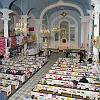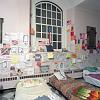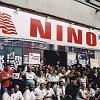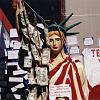
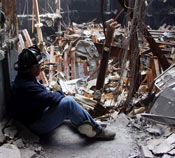
9/26/2001 -- New York City firefighter Tony Marden gazes into the endless rubble of the collapsed World Trade Center. Photo by Mike Rieger/ FEMA News
Refuge
Recovery workers at Ground Zero and the Fresh Kills Recovery Operation worked long, tedious hours at a disturbing task. Emotions and fatigue ran high, but so did the workers' dedication. In an effort to alleviate the workers' physical and mental strain, numerous places of refuge appeared near Ground Zero and at the Fresh Kills facility.
Around Ground Zero it became apparent that clean up workers were in need of local shelter and food. Many workers were unable or unwilling to leave the area in the first few weeks as they continued to search for friends and loved ones and the city was under a state of emergency. Restaurants opened their doors, charitable organizations offered places to rest and receive psychological services, and people donated everything from shaving cream to clean clothes and blankets. Much was done to ease workers' anxiety and exhaustion, in addition to providing them with basic necessities.
St. Paul's Chapel
Built in 1766, St. Paul’s Chapel is one of the oldest churches in New York City and, miraculously, it survived the World Trade Center collapse. The historic chapel has been a place of refuge during difficult times in New York City’s history. It has witnessed the tribulations of the American Revolution and the great New York City Fire of 1835.
The chapel was converted to assist with the recovery efforts. Located a block away from Ground Zero, St. Paul’s Chapel became a respite and haven for police, firefighters, and emergency and clean up workers. Open around the clock, St. Paul’s served hot food and offered a place of rest, physical therapy, and the solace of open ears.
Nino's Restaurant
The Vendome family’s restaurant was located on Canal Street, between Hudson and Varick Street, just a short walk from the World Trade Center. Antonio "Nino" Vendome returned to the restaurant on September 12 and found it in the midst of recovery efforts. He immediately converted it into a place of refuge for police, firefighters and the many, many other rescue workers. More than a half million free meals were provided over the next few months. More importantly, Nino’s became a welcoming respite from the sights and sounds of Ground Zero.
The Coca-Cola Statue of Liberty was found by Mr. Vendome on September 12 in the restaurant’s basement as he was looking for tables to accommodate the rescue workers. It was brought up to the Canal Street sidewalk that day to inspire the rescue effort. Ribbons were strung from the crown onto which donations were clipped.


